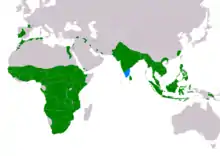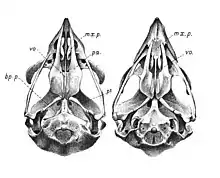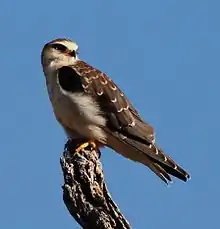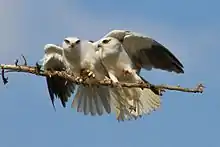Black-winged kite
The black-winged kite (Elanus caeruleus), also known as the black-shouldered kite (not to be confused with the closely related Australian species with the same name), is a small diurnal bird of prey in the family Accipitridae best known for its habit of hovering over open grasslands in the manner of the much smaller kestrels. This Palearctic and Afrotropical species was sometimes combined with the Australian black-shouldered kite (Elanus axillaris) and the white-tailed kite (Elanus leucurus) of North and South America which together form a superspecies. This kite is distinctive, with long wings; white, grey and black plumage; and owl-like forward-facing eyes with red irises. The owl-like behaviour is even more pronounced in the letter-winged kite (Elanus scriptus), a nocturnal relative in Australia. Although mainly seen on plains, they are sometimes seen on grassy slopes of hills in the higher elevation regions of Asia. They are not migratory, but show nomadism in response to weather and food availability. They are well adapted to utilize periodic upsurges in rodent populations and can raise multiple broods in a single year unlike most birds of prey. Populations in southern Europe have grown in response to human activities, particularly agriculture and livestock rearing.
| Black-winged kite | |
|---|---|
_in_Hyderabad_W_IMG_4418.jpg.webp) | |
| E. c. vociferus hovering | |
.jpg.webp) | |
| E. c. caeruleus perched | |
| Scientific classification | |
| Kingdom: | Animalia |
| Phylum: | Chordata |
| Class: | Aves |
| Order: | Accipitriformes |
| Family: | Accipitridae |
| Genus: | Elanus |
| Species: | E. caeruleus |
| Binomial name | |
| Elanus caeruleus (Desfontaines, 1789) | |
| Subspecies | |
| |
 | |
| Range of E. caeruleus Resident Non-breeding | |
| Synonyms | |
| |
Taxonomy

The black-winged kite was described by the French naturalist René Louiche Desfontaines in 1789 and given the binomial name Falco caeruleus.[2][3] It is now one of four species in the genus Elanus which was introduced in 1809 by the French zoologist Jules-César Savigny.[4] The genus Elanus is distinctive in having very small scales covering the foot and on the underside, scutellate scales are found only under the terminal phalanges. The claw lacks a groove on the underside.[5] The word Elanus is from Ancient Greek elanos for a "kite". The specific epithet caeruleus is the Latin for "blue".[6]
There are three subspecies:[7]
- E. c. caeruleus (Desfontaines, 1789) – southwest Iberian Peninsula, Africa, southwest Arabia
- E. c. vociferus (Latham, 1790) – Pakistan to east China, Malay Peninsula and Indochina. The underwing secondaries are smoky grey and nearly white in the nominate subspecies.[8]
- E. c. hypoleucus Gould, 1859 – Greater and Lesser Sunda Islands, the Philippines, Sulawesi and New Guinea
Description
_kite%252C_Elanus_caeruleus%252C_at_Marievale%252C_Gauteng%252C_South_Africa_(45979034625).jpg.webp)
This long-winged raptor is predominantly grey or white with black shoulder patches, wing tips and eye stripe. The long falcon-like wings extend beyond the tail when the bird is perched. In flight, the short and square tail is visible and it is not forked as in the typical kites of the genus Milvus. When perched, often on roadside wires, it often adjusts its wings and jerks its tail up and down as if to balance itself. The sexes are alike in plumage.[9] Their large forward-facing eyes placed under a bony shelf that shades them is distinctive; their velvety plumage and zygodactyl feet[10] are characters shared with owls and the genus has been considered as a basal group within the Accipitridae.[11] They are thought to have been adapted for living in savanna habitats where seasonal rodent population peaks occur. Such food resources are also favoured by the owls. The inner vanes of the feathers have velvety barbules.[12] They have a diploid chromosome number of 68 (some older studies claimed 64 for E.c.caeruleus and 66 for E.c.vociferus) with a distinct karyotype with resemblances to the kites and honey buzzards and suggesting a basal position within the diurnal birds of prey.[13][14]
Distribution and habitat
The black-winged kite is a species primarily of open land and semi-deserts in sub-Saharan Africa and tropical Asia, but it has a foothold within Europe in Spain and Portugal. The species range appears to be expanding in southern Europe and possibly in West Asia.[15][16][17] The first records of breeding in Europe were in the 1860s and since then they have become more widespread and populations are on the rise. It is thought that land-use changes, particularly agriculture and pastureland have helped the species.[18]

Several geographic populations have been named as subspecies and these include the nominate subspecies which occurs in Spain, Africa and Arabia. The subspecies vociferus is found east of this range across South Asia and into Southeast Asia. Along Sumatra, Java, Borneo and the Philippines subspecies hypoleucus (sometimes considered a full species) includes the population wahgiensis described from New Guinea. Subspecies sumatranus is not always recognized. The white-tailed kite and the black-shouldered kite were formerly included with this species but have since been treated as separate species.[19][20]
Although found mainly on the plains they have been seen at higher altitudes in Sikkim (3,650 m (11,980 ft)),[21] the Nilgiris (Doddabetta, 2,670 m (8,760 ft))[22] and Nagaland (2,020 m (6,630 ft)).[23]
They are said to be winter visitors in some parts of their range such as the Western Ghats.[9]
Behaviour and ecology

The black-winged kite breeds at different times of the year across its range. Although nesting has been noted throughout the year in India, they appear not to breed in April and May. Males establish territories and defend them from competition. Females move into the territories of males. Studies in Africa found that males were more numerous than females.[24] Courtship is noisy and involves chases and once the pair is formed they copulate frequently.[25] The nest is a loose platform of twigs in which 3 or 4 eggs are laid. The female spends more effort in the construction of the nest than the male. The eggs are pale creamy with spots of deep red. Both parents incubate but when the chicks hatch, the male spends more time on foraging for food.[9] Females initially feed the young, sometimes hunting close to the nest but will also receive food from the male. After fledging the young birds continue to be dependent for food on the male parent for about 80 days, initially transferring food at perch and later in the air.[26] Young birds have reddish brown feathers on the upperparts and on the breast. The reddish colour is derived from porphyrins and is thought to provide the young birds some camouflage.[10] Once breeding is complete females often move on to new territories sometimes deserting before the young fledge, leaving males to feed and raise the young. Both males and females show considerable nomadism.[24] Unlike most birds of prey, they are capable of raising multiple broods in a year, and young birds are known to disperse widely, adaptations that helps them utilize periodic rodent population surges.[27] Their opportunistic breeding capabilities are also accompanied by irregular patterns of moult. Young birds show "arrested" moult, retaining feathers for a season and then rapidly moulting them in a serial descendent pattern, where more than one primary feather is moulted at the same time. The adult plumage is found after two years.[28]
Their prey includes grasshoppers, crickets and other large insects, lizards, and rodents. Injured birds, small snakes and frogs have also been reported.[9] The black-winged kite flies slowly during hunting like a harrier, but it will also hover like a Kestrel. It has on rare occasions been known to hunt prey in flight.[29] Perches are used for hunting and for feeding but large prey may sometimes be handled on the ground.[30] In southern Africa, they appear to favour roadside verges for foraging and are sometimes killed by collisions with vehicles.[31]

These birds roost communally with groups of 15 to 35 (larger numbers in Europe[32]) converging at a large leafy tree.[33] They are extremely silent and the calls recorded include a high-pitched squeal or a soft whistle.[9] They call mainly during the breeding season and at the roost site.[34][35] A species of nematode, Physaloptera acuticauda, has been recorded as a parasite of the species in South Africa.[36] A trematode species, Neodiplostomum elani, has been described from a black-winged kite type host from Chandigarh.[37] A feather louse Degeeriella elani is known from the species.[38]
The soft feathers of black-winged kites can lead to adherence with some grass seeds which may be dispersed by the species. However such seeds can pose the risk of entangling their wings.[39]
References
- BirdLife International (2019). "Elanus caeruleus". IUCN Red List of Threatened Species. 2019: e.T22695028A152521997.
- Desfontaines, René Louiche (1789). "Mémoire sur quelques nouvelles espèces d'oiseaux des côtes de Barbarie". Histoire de l'Académie Royale des Sciences, Avec les Mémoires de Mathématique et de Physique (in French): 503, Plate 15. The title page gives the year as 1787 and the year of publication as 1789.
- Mayr, Ernst; Cottrell, G. William, eds. (1979). Check-list of Birds of the World. Volume 1 (2nd ed.). Cambridge, Massachusetts: Museum of Comparative Zoology. p. 291.
- Savigny, Jules-César (1809). Jomard, Edme-François (ed.). Description de l'Égypte, ou recueil des observations et des recherches qui ont été faites en Égypte pendant l'expédition de l'armée française, publié par les ordres de sa Majesté l'Empereur Napoléon le Grand (in French). Volume 1. Paris: L'Imprimerie Impériale. pp. 69, 97–98.
- Ridgway, Robert (1900). A manual of North American Birds. Philadelphia: J.B. Lippincott Co. p. 222.
- Jobling, James A. (2010). The Helm Dictionary of Scientific Bird Names. London: Christopher Helm. pp. 82, 144. ISBN 978-1-4081-2501-4.
- Gill, Frank; Donsker, David, eds. (2017). "New World vultures, Secretarybird, kites, hawks & eagles". World Bird List Version 7.3. International Ornithologists' Union. Retrieved 31 December 2017.
- Forsman, Dick (2016). Flight Identification of Raptors of Europe, North Africa and the Middle East. Bloomsbury Publishing. pp. 114–118.
- Ali, S.; Ripley, S.D. (1978). Handbook of the birds of India and Pakistan. 1 (2nd ed.). Oxford University Press. pp. 212–214. ISBN 978-0-19-562063-4.
- Negro, Juan J.; Bortolotti, Gary R.; Mateo, Rafael; García, Isabel M. (2009). "Porphyrins and pheomelanins contribute to the reddish juvenal plumage of black-shouldered kites". Comparative Biochemistry and Physiology Part B: Biochemistry and Molecular Biology. 153 (3): 296–299. doi:10.1016/j.cbpb.2009.03.013. PMID 19351566.
- Negro, Juan J.; Pertoldi, Cino; Randi, Ettore; Ferrero, Juan J.; López-Caballero, José M.; Rivera, Domingo; Korpimäki, Erkki (2006). "Convergent evolution of Elanus kites and the owls" (PDF). Journal of Raptor Research. 40 (3): 222–225. doi:10.3356/0892-1016(2006)40[222:CEOEKA]2.0.CO;2. hdl:10261/33813.
- Negro, Juan J.; Pertoldi, Cino; Randi, Ettore; Ferrero, Juan J.; López-Caballero, José M.; Rivera, Domingo; Korpimäki, Erkki; Boal, Clint (1 September 2006). "Convergent evolution of Elanus kites and the owls". Journal of Raptor Research. 40 (3): 222–225. doi:10.3356/0892-1016(2006)40[222:ceoeka]2.0.co;2. hdl:10261/33813. ISSN 0892-1016.
- Ansari, Helal Ahmad; Kaul, Dipika (1 October 1986). "Cytotaxonomic study in the order Falconiformes (Aves)". Zoologica Scripta. 15 (4): 351–356. doi:10.1111/j.1463-6409.1986.tb00235.x. ISSN 1463-6409.
- Bed'Hom, Bertrand; Coullin, Philippe; Guillier-Gencik, Zuzana; Moulin, Sibyle; Bernheim, Alain; Volobouev, Vitaly (1 April 2003). "Characterization of the atypical karyotype of the black-winged kite Elanus caeruleus (Falconiformes: Accipitridae) by means of classical and molecular cytogenetic techniques". Chromosome Research. 11 (4): 335–343. doi:10.1023/a:1024091923939. ISSN 0967-3849. PMID 12906130.
- Balbontin, J.; Negro, J.J.; Sarasola, N.H.; Ferrero, J.J.; Rivera, D. (2008). "Land-use changes may explain the recent range expansion of the Black-shouldered Kite Elanus caeruleus in southern Europe". Ibis. 150 (4): 707–716. doi:10.1111/j.1474-919X.2008.00845.x.
- Salim, M.A. (2002). "The first records, including breeding, of Black-winged Kite Elanus caeruleus in Iraq". Sandgrouse. 24 (2): 136–137.
- Sehatisabet, M.E.; Musavi, S.B.; Bakhtiari, P.; Moghaddas, D.; Hamidi, N.; Nezami, B.; Khaleghizadeh, A. (2006). "Further significant extensions of migrant distribution and breeding and wintering ranges in Iran for over sixty species". Sandgrouse. 28 (2): 146–155.
- Balbontín, Javier; Negro, Juan José; Sarasola, José Hernán; Ferrero, Juan José; Rivera, Domingo (1 October 2008). "Land-use changes may explain the recent range expansion of the Black-shouldered Kite Elanus caeruleus in southern Europe" (PDF). Ibis. 150 (4): 707–716. doi:10.1111/j.1474-919x.2008.00845.x. ISSN 1474-919X.
- Clark, W.S.; Banks, R.C. (1992). "The taxonomic status of the White-tailed Kite" (PDF). Wilson Bulletin. 104 (4): 571–579.
- Hussain, K.Z. (1959). "Notes on the taxonomy and zoogeography of the genus Elanus" (PDF). Condor. 61 (2): 153–154. doi:10.2307/1365216. JSTOR 1365216.
- Ganguli-Lachungpa, Usha (1990). "Blackwinged Kite Elanus caeruleus vociferus (Latham) at 3650 m in Sikkim". Journal of the Bombay Natural History Society. 87 (1): 142.
- Krishna, M.B. (1979). "The range of the Blackwinged Kite". Newsletter for Birdwatchers. 19 (7): 10.
- Choudhury, A. (1996). "New elevation record for Black-winged Kite from Nagaland". Newsletter for Birdwatchers. 36 (5): 96.
- Mendelsohn, John M. (1 March 1983). "Social Behaviour and Dispersion of the Blackshouldered Kite". Ostrich. 54 (1): 1–18. doi:10.1080/00306525.1983.9634437. ISSN 0030-6525.
- Ferrero, J.J.; Grande, J.M.; Negro, J.J. (2003). "Copulation behavior of a potentially double-brooded bird of prey, the Black-winged Kite (Elanus caeruleus)" (PDF). Journal of Raptor Research. 37 (1): 1–7.
- Bustamante, J. (1993). "The post-fledging dependence period of the Black-shouldered Kite (Elanus caeruleus)" (PDF). Journal of Raptor Research. 27 (4): 185–190.
- Václav, Radovan (1 January 2012). "First observation of the black-winged kite Elanus caeruleus in Slovakia". Slovak Raptor Journal. 6 (1): 27–30. doi:10.2478/v10262-012-0062-y. ISSN 1337-3463.
- Herremans, M. (1 May 2000). "Cases of serial descendant primary moult (Staffelmauser) in the Black‐shouldered Kite Elanus caeruleus". Ringing & Migration. 20 (1): 15–18. doi:10.1080/03078698.2000.9674222. ISSN 0307-8698.
- Lamba, B.S. (1969). "Blackwinged Kite, Elanus caeruleus vociferus (Latham) taking in flight a wounded Green Pigeon, Treron phoenicoptera (Latham)". Journal of the Bombay Natural History Society. 66 (3): 622.
- Tarboton, W.R. (1978). "Hunting and the Energy Budget of the Black-Shouldered Kite". The Condor. 80 (1): 88–91. doi:10.2307/1367793. JSTOR 1367793.
- Dean, W.R.J.; Milton, S.J. (2003). "The importance of roads and road verges for raptors and crows in the Succulent and Nama-Karoo, South Africa". Ostrich. 74 (3&4): 181–186. doi:10.2989/00306520309485391.
- Parejo, D.; Avilés, J.M.; Ferrero, J.J.; Rivera, D. (2001). "Communal roosting and diet of Black-shouldered Kite Elanus caeruleus wintering in the southwest of Spain" (PDF). Journal of Raptor Research. 35: 162–164.
- Bharos, A.M.K. (1997). "A large communal roost of Blackwinged Kites Elanus caeruleus". Journal of the Bombay Natural History Society. 94 (3): 566.
- Sharma, A.K. (1993). "Courtship display of Blackwinged Kite". Newsletter for Birdwatchers. 33 (3): 54.
- Srinivas, V. (2002). "A large congregation of black-shouldered kite Elanus caeruleus at Ranthambore National Park". Journal of the Bombay Natural History Society. 99 (2): 297.
- Ransom, B.H. (1904). Manson's eye worm of chickens. USDA, Washington. p. 42.
- Gupta, N. K.; Mehrotra, V. (1970). "Neodiplostomum (Neodiplostomum) elani n.sp. from Elanus caeruleus (Desfontaines) at Chandigarh". Research Bulletin of the Panjab University. 21 (3/4): 329–332.
- Clay., Theresa (1 March 1958). "Three New Species of Degeeriella Neumann (mallophaga) from the Falconiformes (aves)". Proceedings of the Royal Entomological Society of London B. 27 (1–2): 1–7. doi:10.1111/j.1365-3113.1958.tb01512.x. ISSN 1365-3113.
- Mendelsohn, J. M. (1983). "Causes of mortality in Black-shouldered Kites". Bokmakierie. 35: 11–13.
Other sources
- Hume, A.O. (1872). "On the breeding of Elanus Melanopterus". Stray Feathers. 1 (1): 21–26.
- Hodgson, B.H. (1837). "On the structure and habits of the Elanus melanopterus". Madras Journal of Literature and Science. 6: 75–78.
- Goriup, P.D. (1981). "Observations on a pair of Black-winged Kites (Elanus cueruleus) in eastern Portugal". Arquivos Museu Bocage. B. 1: 65–79.
- Naoroji, Rishad (1986). "Communal gathering of Blackwinged Kites (Elanus caeruleus vociferus)". Journal of the Bombay Natural History Society. 83 (Supp): 200–201.
- Harris, T.; Walters, C. (1982). "Chromosomal sexing of the Black Shouldered Kite (Elanus caeruleus) (Aves: Accipitridae)". Genetica. 60 (1): 19–20. doi:10.1007/BF00121451.
External links
| Wikimedia Commons has media related to Elanus caeruleus. |
| Wikispecies has information related to Elanus caeruleus. |
- (Black-winged Kite or ) Black-shouldered Kite species text in The Atlas of Southern African Birds
- "Common Black-shouldered Kite media". Internet Bird Collection.
- Ageing and sexing (PDF; 0.95 MB) by Javier Blasco-Zumeta & Gerd-Michael Heinze
- Black-shouldered Kite photo gallery at VIREO (Drexel University)
- Interactive range map of Elanus caeruleus at IUCN Red List maps
- Original species description by Desfontaines (in French, 1787), with illustration pl. 15
- Illustrations, plate 36 and pl. 37, with description in French by Levaillant (1799).
